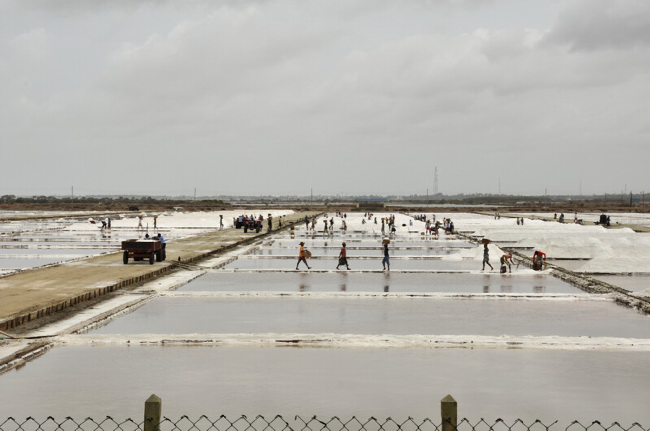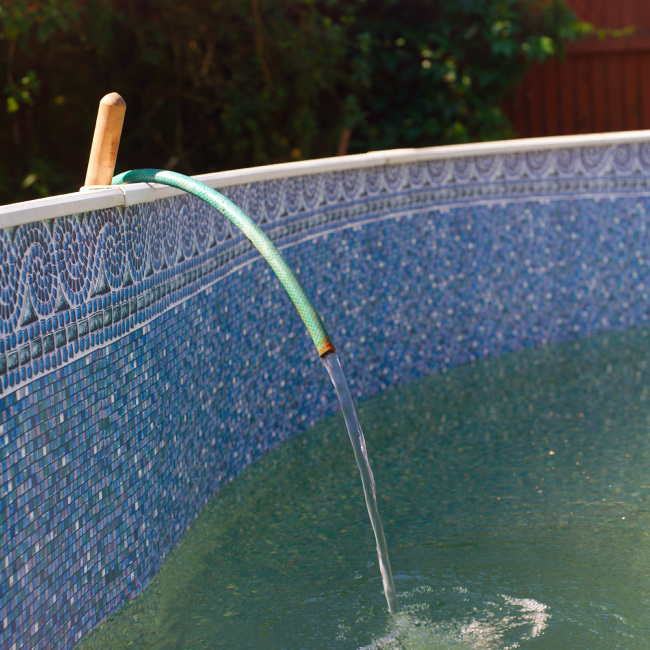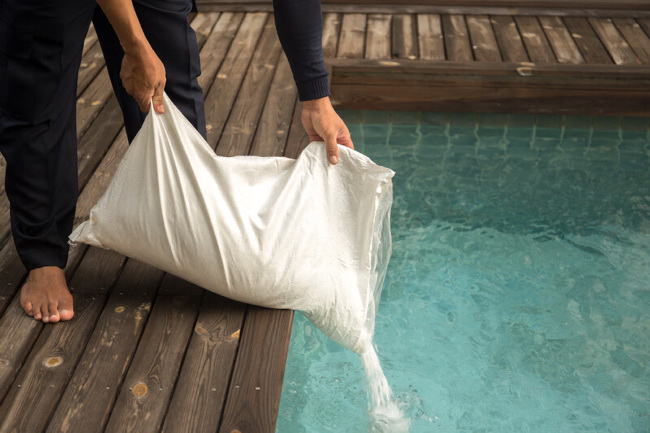Have you just read your salt level and it’s showing 4,000 ppm or more? Maybe you added too much salt for your pool. Or perhaps your pool water level has dropped resulting in high salt concentration. How do you go about fixing it now?
To lower your pool’s high salt level, you’ll need to dilute the water. You can do this by either topping up the water level or by partially draining before refilling the pool. However, you’ll need to know the pool volume and salt concentration before you can do that.
A high salt level could cause your salt cell or saltwater generator to stop working. High salinity levels in pools also have a corrosive effect. It’s also likely your pool water will taste salty. This may not be the only reason though: Pool Water Tastes Salty – Why?
Read on to learn how to correct salt levels (also known as salinity levels) with some math and freshwater.
Article Contents
Will Evaporation Lower Salt Level?
It’s understandable to think that salt would evaporate with the water. That a decent solution is to wait for the salt to dissipate back into nature to correct the salt level in your pool. However, salt doesn’t turn to vapor, because it is a mineral.
In saltwater, water molecules are responsible for keeping salt particles apart. This is why salt will leave deposits in the absence of water. When the water in a saltwater pool evaporates, salt particles still remain.
This is how salt has been made for centuries. It’s simply a matter of leaving a salt water solution in the sun to evaporate. What’s left is salt.

That’s why, the fewer water molecules there are to separate salt particles increases the pool’s salinity. And increases the risk of corrosion. In other words, as the water evaporates, the concentration of salt (salinity) gets higher.
Additionally, salt doesn’t decompose over time. So, dilution is the best and only option to lower your pool’s salt levels successfully.
Ways to Lower Salt Level
Here’s how to lower the salinity (salt level) of your pool:
- Top up with fresh water.
- Partially drain the pool before refilling it.
But before you address the problem, you’ll need to test your salt level. The ideal range your pool’s salinity should be in is between 2,500-4,000 ppm (parts per million). This will depend on the salt cell brand. Check the salt cell instructions for the ideal levels. Generally, 3,200 ppm is the optimal salinity level in many saltwater pools.
Readings below 2,500 ppm mean the chlorinator (saltwater generator) isn’t going to effectively produce chlorine. Readings over 4,000 ppm result in an increased risk of corrosion in your pool and reduced salt cell functionality.
However, the concentration doesn’t need to be exactly at these numbers because there is a grace range of a couple of hundred ppm on either side.
How To Find Your Pool’s Ideal Salt Level
Most modern saltwater generators come with a control panel where you can read the salt level (as well as other levels) from. However, testing the water yourself with a drop test kit gives you a more accurate reading. Generally, control panels are prone to giving incorrect readings, possibly due to dirty sensors or calibration issues.
A way to keep your control panel reading an accurate salt concentration is to ensure that the salt cell stays clean. Learn how to clean yours like a pro here.
Although it’s not as simple as finding the level from the control panel, drop test kits will give you a more accurate reading. Before using a drop kit, some pool experts recommend ensuring your pool’s volume is at its rated capacity first. After topping up your pool, let it circulate for 24 hours before testing to get a more accurate measurement.
Now you can test. After that, collect a sample of pool water in a small, clean cup. Usually, 0.5 fl oz (14 ml) of water will be enough.
Use a quality test kit like this Taylor test kit.
- For saltwater pools
- Extremely accurate
- Tests 7 things including salt, pH, chlorine, cyanuric acid
Or you can use test strips. Dip the saltwater test strip into the cup and leave it in the cup until the strip turns color. Finally, check the given readout and find out the ppm by comparing it to the included conversion table.
A popular brand of test kits for saltwater pool are the AquaChek Salt Test Strip Titrators, which have a rating of 4.5 stars out of 3,239 Amazon reviews. You can get it here:
- Quickly test your saltwater pool's salt levels
- Accurate measurements for salt levels from 400 to 7,000 ppm
- Easy to use, no measuring & counting drops
It contains 10 test strips and features a free app to keep a record of your testing history. However, some customers have noticed that there were inaccuracies between their reading and the automated one.
Refreshing Pool with Water
When the water level drops naturally, this refresh method is a great option. This drop in water may be due to evaporation or water splashing out after heavy use. When this happens, there will be an increase in salinity level.
So, to lower the salt concentration in this case:
- Make sure to test the salt level first before attempting anything else.
- Refill your pool with fresh water from a garden hose or wherever you get your water supply from.
- After that, let the water circulate the pool for a few hours.
- Then, collect a new sample and follow the testing instructions.
- If the reading is still too high, drain six inches and repeat the steps.

Although this way of diluting your pool is easy and quick, it will take some trial and error to correct the ppm for your pool.
Partially Draining Your Pool
If you’re getting a very high reading, the best option might be to partially your pool before refilling it. However, this method requires some math, pool knowledge, and the possible rental/purchase of a pool drainage pump.
So, to successfully partially drain and refill your pool:
- First take a salt concentration reading using a test kit, regardless of what your SWG (saltwater generator) control box says.
- Then, refer to your pool’s manual to check the pool’s volume capacity. Otherwise, you’ll need to calculate the pool volume yourself.
- Work out how much water you’ll need to drain, using the pool’s overall volume. i.e. if you find your salt levels are 20% higher than they should be, you’ll need to drain and dilute the pool’s water by 20%.
- Refill the pool with fresh water using a garden hose or wherever you get your water supply from.
- Let it circulate for a few hours and carry out another salinity test. If it’s still high, you may need to repeat this process.
- Finally, check the salt reading again after 24 hours. If your pool’s salt concentration is within a few hundred ppm of the recommended level, it’s safe to swim in.
You may choose to buy a sump drain pump to when you’re fixing your pool’s salinity level. It’s best not to use the pool pump and if you’re going to reduce the level below the skimmer, definitely don’t use the pool pump otherwise you’ll be introducing air into the system.
The FibroPool Electric Drain Pump is suitable for both in-ground and above-ground pools.
- Durable & lightweight
- Quickly removes still water
- Designed for in-ground and above-ground pools
This pump has a rating of 4.5 stars out of 3,827 Amazon reviews. It drains 600 gallons per hour (2,728 L per hour) and has a 16 ft (4.8 m) chord which saves you time and energy with draining your pool. However, some buyers noticed they could not get the kinks out properly.
An important factor is that most cities don’t allow pool water to drain into public areas so you’ll need to drain it into your yard or house’s sewer.
How Much Water to Drain?
To understand how much water you need to drain to start correcting the salt level, you’ll need to find out the pool’s overall volume.
Pool Volume
If you can’t find the manufacturer’s manual that states the volume, or your pool isn’t completely full, you can calculate the volume yourself.
| Pool Shape | Formula to use to find volume |
| Rectangular | width x length x depth x 7.48 gal (28.3 L) |
| Circular | π x radius2 x depth x 7.48 gal (28.3 L) |
| Oval | π x ½ width x ½ length x depth x 7.48 gal (28.3 L) |
| Variable Depth | Find the average depth: shallow end depth x deep end depth ÷ 2. Use this depth when using other formulas |
| Irregularly shaped | Calculate each section using the other formulas and add together |
Calculating How Much Water to Drain
The first thing you need to do is find out the recommended ppm for your saltwater system. Then divide the pool’s current ppm by the recommended amount. With this figure, you only use the numbers after the decimal point which you then multiply with the pool’s volume.
For example, your pool is 10,000 gal (45461 L) and your current ppm is 4,500 but the recommended is 3,200 ppm. Divide 4,500 by 3,200 to get 1.40. Then multiply the pool’s volume by 0.40 to get 4,000 gal (18184 L). This is the amount of water you need to drain your pool before refilling it.
Correct Salt Level For My Pool
Finding the correct salt level for your pool depends on the saltwater generator itself. Below are some of the most common brands of SWGs and their ideal and optimal salinity levels.
| Brand | Ideal Range (PPM) | Optimal Value (PPM) |
| Intex | 2,500 to 3,500 | 3,200 |
| CircuPool | 3,000 to 4,000 | 3,500 |
| Jandy | 2,500 to 4,000 | 3,000 to 3,500 |
| Hayward | 2,700 to 3,400 | 3,200 |
| Pentair | 2,800 to 4,500 | 3,600 |
Maintaining the correct salt level (within a few hundred ppm) is crucial to a healthy pool. Too low salt results in the saltwater generator not being able to properly sanitize the pool.
Too high salt increases the risk of corrosion to the generator itself and any other metallic equipment in the pool.
As well as having the correct salt levels, to maintain a clean pool you also need to run your saltwater generator for the correct amount of time. How long? Check out our article here that explains all:
How Long To Run Saltwater Chlorine Generator (Chlorinator) & Pump?
Why Is There Too Much Salt in Pool?
The most common reason there’s too much salt in your pool is either from adding too much salt (usually a miscalculation) or inaccurate readings.

The other reason is a low pool water level. When the water is low, this can lead to a higher concentration of salt.
It’s not uncommon for pool owners to overestimate or underestimate the size of their pool especially if they’re new to pools. So, they miscalculate how much salt the pool needs.
The other reason may be inaccurate testing kits or a false reading from the control panel. Many test strips can give a false salt concentration reading of the pool, resulting in too much additional salt. This is why I recommend using drop test kits. And why I advise pool owners to manually test the salinity level.
Problems with Too Much Salt
Having a pool with a high salt content (over 4,500 ppm) will result in problems with your chlorinator and any other metallic elements in the pool. Saltwater generator manufacturers have a range in which the generator properly works within.
So, when the salinity level is outside that range, chlorinator will stop producing chlorine efficiently. Which means the free chlorine could be low, and total chlorine is high. Your control panel may also switch on a warning light.
See this article here for an explanation of the warning lights on your saltwater chlorine generator control panel.
Not only will the water taste more salty than normal, but the overly salted water will also be more corrosive in the pool. It will wear down ladders, submerged lights, and metallic components within the pool. It can even corrode the lining of the pool or the base, is made of metal.
Final Thoughts
Lowering your pool’s salt concentration comes down to dilution. How you go about that depends on the water level of the pool and how high the salinity reading is.
However, with some math and help from manfacturer manuals, you can confidently lower your pool’s salt level.




